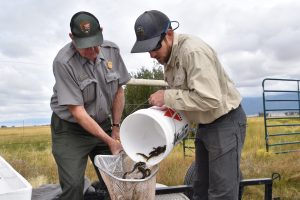When plants and animals wind up on the threatened or endangered species lists, it can mean two things: They’re in dire straits — and they’ll have access to a host of federal protections.
Two southwestern fish, the Rio Grande chub and sucker, did not make the list.
It’s a bittersweet outcome for conservation groups. The federal decision, announced in June, is a sign that years of multi-agency conservation efforts are helping the species. But more protections could also come in handy: One-third of the fish populations could die off in the next decade, and environmental threats, like being eaten by non-native fish, aren’t going anywhere.
“We can certainly breathe a sigh of relief and pat ourselves on the back a little bit, but the job’s not done,” said Dan Cammack, an aquatic biologist and resident “it-guy” for sucker and chub conservation at Colorado Parks and Wildlife.
The Rio Grande chub, a small fish that loves eating insects, plankton and crustaceans, was formerly the most common fish in the Rio Grande river basin. The Rio Grande sucker, known for its bright red racing stripe, can be found scraping algae off rocks like hungry vacuum cleaners that clean Colorado’s rivers.
“With these species, sometimes it’s not just one thing. It’s death by a thousand cuts,” Cammack said.
In the 1990s, Colorado designated the sucker as state endangered and the chub as a state species of special concern. Those designations continue, regardless of the federal decision.
In the early 2010s, the advocacy group WildEarth Guardians said these and other existing regulations to protect the species weren’t enough to counteract the many threats to the fish. The group submitted petitions to the U.S. Department of the Interior to list the chub and sucker as endangered or threatened.
The petitions launched a federal review process that culminated in its final decision that the fish are not in danger of extinction across their entire range.
“It’s disappointing to see the [U.S. Fish and Wildlife] Service deny protections to two species whose populations have been in severe decline, especially when climate change will only exacerbate current threats,” said Joanna Zhang, wild rivers advocate with WildEarth Guardians, in a news release.
Cammack said the outcome was a sign that existing conservation efforts were working.
“I would definitely characterize this as a victory for really anybody,” he said. “None of us should want to see a species end up on the endangered species list.”
The federal rationale
In 2013 and 2014, WildEarth Guardians petitioned the Interior Department to list the Rio Grande chub and sucker as threatened or endangered.
More than 25 non-native species, like the northern pike, white sucker and brown trout, found their way into the Rio Grande drainage. Some eat the chub’s and sucker’s food or take up their habitat, and others simply eat the chub and sucker.
Over time, dams blocked their migration patterns; diversions sucked water out of streams for farms and cities; and human activities damaged riverside ecosystems. Then, there is the ever-present threat of higher temperatures in a changing climate.
Existing programs and regulations weren’t enough to protect the chub, the group argued.
However, the fish populations are spread across different environments in Colorado, New Mexico, Texas and Mexico, a wildfire — or diversions or predators — in one area would not cause the whole species to go extinct across the species’ entire range.
Therefore, the sucker and chub were not at risk of extinction and listing them as endangered or threatened was not warranted, the analysis said.
“The federal process was a sound process,” Cammack said. “We really ought to, as state agencies, be aiming to not go [on the list]. If a species is eligible for listing, we’ve let it fall too far. That’s a pretty dire state.”
Is current conservation enough?
Cammack has spent years trekking through streams, doing population counts and restocking fish populations, to try to keep the chub and sucker off the endangered species list.
Wildlife officials have been reintroducing Rio Grande suckers to streams in Colorado and New Mexico since 1995. Colorado Parks and Wildlife annually stocked hatchery-raised Rio Grande chub into the mainstem of the upper Rio Grande most years from 2002 to 2019. New Mexico has done its own fish stocking projects, and nonprofits, like the Rio Grande Headwaters Restoration Project, have pitched in.
Agencies entered into a 10-year conservation agreement for the chub and sucker signed in 2018. The agreement outlines long-term management goals, like monitoring populations and habitat, boosting population counts and improving watershed conditions.
The teamwork has been great, but funding, particularly long-term, durable funding, is an ongoing challenge for these projects, said Daniel Boyes, executive director of Rio Grande Headwaters Restoration Project.
Listing the fish as threatened or endangered under the Endangered Species Act would have added new layers of regulations and additional resources to help protect the fish.
Once listed, prohibitions on killing or harming a species can go into effect. Listing four species as endangered in the Colorado River Basin created an extensive recovery program and allocated more funds toward recovery, Cammack said.
There, the Upper Colorado River Endangered Fish Recovery Program puts extensive resources into helping the fish populations. Reservoir operators, farmers, ranchers, water districts and others across the state work together to make sure required amounts of water reach critical fish habitat, like a 15-mile stretch of the Colorado River near Grand Junction.


 Print
Print